I wrote for Folks, “an online magazine dedicated to telling the stories of remarkable people who refuse to be defined by their health issues. When it comes to understanding health, no one is exactly the same. By sharing the experiences of these individuals, we hope to change people’s notions about what it means to be ‘normal’.”
Here’s my author page (which still says I’m 29, and I’m correcting no one).
A rundown of some of the stories I’ve done:
‘The deaf politician who listens to everyone.’ Who is Mojo Mathers, beyond being New Zealand’s first deaf MP?
When she began her political career, Mojo says had “no concept of the challenges that lay ahead for me as a deaf candidate and 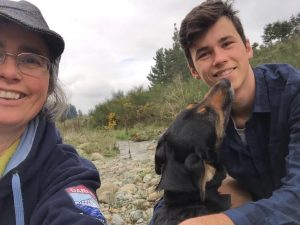 activist.” For the first few months, she suffered heavily from concentration fatigue as she tried to keep up with the fast-moving debates that happen in and out of parliament.
activist.” For the first few months, she suffered heavily from concentration fatigue as she tried to keep up with the fast-moving debates that happen in and out of parliament.
“One of the tough things about my job has been learning to accept the bouquets and discard the brickbats,” she said on Facebook. “Today I got told by a lovely older woman that my maiden speech had made her cry and it was a “must watch.” A few hours later I got told by a male that my voice was ‘too flat’ and I needed to get more emotion into it without being ‘creepy intense.’ I’ll just take the first, thank you.”
‘The strange rewards of being sick’
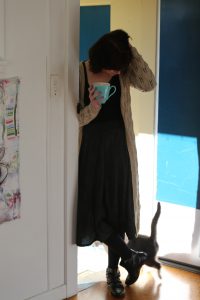 I hated writing this, I’m not gonna lie. Even though I’m pretty used to writing about myself, when Folks suggested I do a first-person piece about living with arthritis etc, I was like nooooo. I feel like I come across as sanctimonious. But anyway, this is basically about there being something of a silver lining to the way my life has gone, and what I’ve learned from having a chronic illness.
I hated writing this, I’m not gonna lie. Even though I’m pretty used to writing about myself, when Folks suggested I do a first-person piece about living with arthritis etc, I was like nooooo. I feel like I come across as sanctimonious. But anyway, this is basically about there being something of a silver lining to the way my life has gone, and what I’ve learned from having a chronic illness.
‘There is more in you’ – Danae Lee’s journey to Outward Bound
I’ve known Danae for a while, but it was awesome to write this because I got to know her a lot more.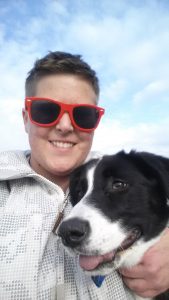 She has Lupus, among other things, but is super active, and has always wanted to do Outward Bound. She thought her illness would rule it out, but Outward Bound has a course called Aspire, which caters for people with some reduced capabilities.
She has Lupus, among other things, but is super active, and has always wanted to do Outward Bound. She thought her illness would rule it out, but Outward Bound has a course called Aspire, which caters for people with some reduced capabilities.
“The people on my course are some of the most amazing people I’ve ever met. We came from diverse backgrounds in terms of age, gender and health, but I shared so many things in common with many of them. To me this was probably one of the greatest aspects of the course; meeting people who have been through many of the same or similar struggles that I have, especially in terms of chronic illness.”
“I’m loathe to use the word ‘inspiring,’ but it was. It made me feel like; ‘We got this. We’re gonna be ok, even if we’re not ok, you know?”
‘Life on the opium couch‘ – about Stephanie de Montalk, author of How Does it Hurt?
“The idea of a book that would raise awareness of, and bring a degree of clarification to, chronic pain arose primarily as a result of the misunderstanding I was experiencing with my own constant pain.
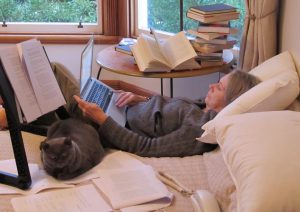 I felt exiled, isolated, and very much aware that family, friends and even medics were uncomfortable with the subject, reluctant to discuss it. Many were reluctant to believe that chronic pain was not simply akin to a troublesome cough. This situation was magnified by the fact that my nerve entrapment and damage were rare, and not known about in New Zealand at the time of my accident. I had to fly to Nantes, France for diagnosis and surgery.
I felt exiled, isolated, and very much aware that family, friends and even medics were uncomfortable with the subject, reluctant to discuss it. Many were reluctant to believe that chronic pain was not simply akin to a troublesome cough. This situation was magnified by the fact that my nerve entrapment and damage were rare, and not known about in New Zealand at the time of my accident. I had to fly to Nantes, France for diagnosis and surgery.
I was aware that others in pain were additionally suffering from emotional pain through an absence of validation of their physical pain, and wondered if, as a writer, I might be able to help…”
‘Pinky Fang, the artist with different eyes.’ Blindness doesn’t always mean you can’t see anything.
““If you don’t inherit Retinitis Pigmentosa, it can happen to you pretty fast,” says Pinky. “But for me, it’s been a slow decline my whole life. I guess it’s a genetic lottery what type of eyes you get.”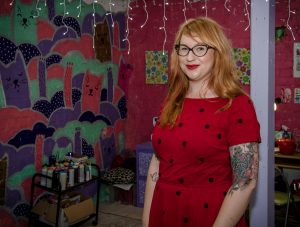
Her art has a distinctive bold, quirky style, and she works in a wide range of disciplines, including drawing, painting, jewellery and textile design.
“I like to insert my sense of humour into my work. Nothing I do is generally too serious or meaningful – I just like to create things that people will find interesting & take some enjoyment from. I like people to laugh or smile when they see my work.”
“I’ve always been a cat lover. There’re quite a few people now who have personalised Kitty Gang tattoos, which is amazing – it’s the hugest honour to have people literally wear your work on their skin.”
‘A lion in the day.’ How Katherine Mansfield fought arthritis, depression, and tuberculosis to write.
“I’m a lion all day, darling, but with the last point of daylight I begin to turn into a lamb and by midnight—mon Dieu! by midnight the whole world has turned into a butcher.”
– Katherine Mansfield, in a letter to her husband, 1913.
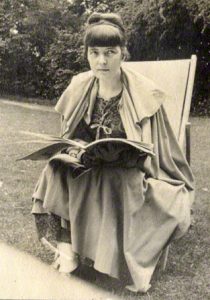
by Lady Ottoline Morrell, 1916-1917
With fevers, joint and abdominal pain, inflammation in her hands and rashes from arthritis, the fatigue, coughing, and loss of appetite and weight caused by tuberculosis, it seems nothing short of a miracle she managed to be so prolific. I scoured her words for some clue to her strength of character and tenacity.
In strange foreshadowing of my search, she said in 1922; “’I think the only way to live as a writer is to draw upon one’s real familiar life – to find the treasure in that.…And the curious thing is that if we describe this which seems to us so intensely personal, other people take it to themselves and understand it as if it were their own…”
‘Tiny tales on her fingertips.’ Anthea Whittle copes with her neurological condition by painting with polish.
When Anthea Whittle was eleven years old, she made a deal with her piano teacher. For ever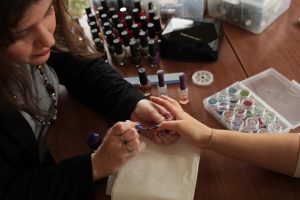 y lesson that Anthea turned up with her nails cut short enough to play, her tutor would reward her with a bottle of nail polish.
y lesson that Anthea turned up with her nails cut short enough to play, her tutor would reward her with a bottle of nail polish.
“When I last tried to add it all up, it was maybe four hundred bottles?” she laughs. “But since then, gel polishes were invented and I started getting those, now I really have no idea.”Now, at 28, she’s a self-taught nail artist who’s been collecting polishes – and everything that goes with them – for seventeen years. She’s lost count of how many she has.
Anthea has a rare neurological condition called Idiopathic Intracranial Hypertension.
‘An unbreakable silver thread, woven through everything.’ Illustrator and comic artist Jem Yoshioka explores her history of illness and her unique heritage through art that’s reached thousands.
“I was able to be in Japan to commemorate the 70th Anniversary of the Hiroshima bomb, which my grandmother survived. I got to spend time with my great uncles, see places important to my family and travel with my younger brother. A three week trip with so much walking would have been absolutely unthinkable as little as 5 years ago.
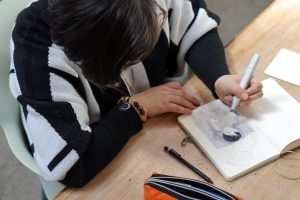 I am so grateful that my body has been able to recover to the point where I can walk around.
I am so grateful that my body has been able to recover to the point where I can walk around.
Artistically I think these trips will be feeding me for a long time. Japan is very important to me and this will be a common theme through my work, but it’s also important to know I’m not from Japan, I’m from New Zealand, and so my worldview and the work I make is different because of that.”
